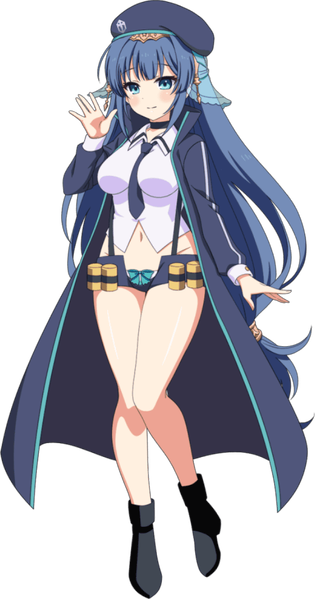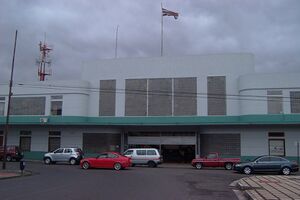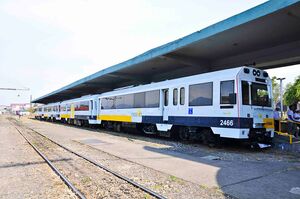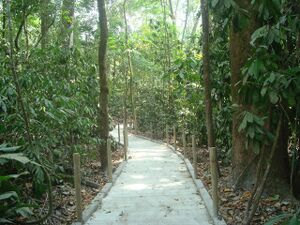Costa Rica
| Costa Rica | |||||
|---|---|---|---|---|---|
| Japanese Name | コスタリカ | ||||
| Weapon | |||||
| Race | Human | ||||
| Nationality | |||||
| Birthday | July 23 | ||||
| Constellation | Leo | ||||
| Talents | Ancient Flamarinian magic, Raising plants and animals | ||||
| Likes | Flora and fauna, Globes | ||||
| Dislikes | Nothing in particular | ||||
| Strengths | Full of mercy and compassion | ||||
| Weaknesses | Morbidly overprotective | ||||
| Hobbies | Traveling | ||||
I'm an shrine maiden sworn to protect Flamarine's seas and lands. I helped set up the barrier at the Underwater Temple. They liked me for my skills so much that they employed me as the chairperson to open the summits at the temple. Though I have now left the position for a myriad of reasons.
Layers
| Icon | Title | Release Date | Where to Obtain |
|---|---|---|---|
| [Underwater Temple Ex-Chairwoman] Costa Rica | 2021 July 23 | [Amorous Owl and the Pure Archer] Limited Gacha | |
| [Motherly Valentine] Costa Rica | 2023 January 31 | [The Sickness Unto Chocolate] Limited Gacha | |
| [Mother Ocean] Costa Rica | 2021 October 5 | Tower Ticket Gacha, Panel Mission | |
| [With Motherly Love From the Sea] Costa Rica | 2023 June 30 | [Summer Holiday Rhapsody ~The Picture Diary Where Drawings Become Reality~] Pick Up Gacha, Premium Gacha |
Skills
Trivia
- Costa Rica's birthday is the opening date of Ferrocarril al Pacifico of Costa Rica in 1910.
- Costa Rica's retired position as head priestess of the Flamarine Temple is likely a reference to the current status of Ferrocarril al Pacifico, as while the railway network is extensive and wide, railways are in disrepair and only slowly being reactivated after having been shut down in the 1990s.
- The butterflies featured in [Mother Ocean] is the Blue Morpho Butterfly, the national animal of Costa Rica. The bright blue color is not actually blue, but because of the deep, reflective scales on the wings, creating a Tyndall scattering phenomenon so that the light reflects through them and a brilliant blue color gets created.
- In addition, Costa Rica's hair appears to change between black and blue in her illustrations, likely referencing the above Tyndall scattering effect.
Counterpart
Ferrocarril al Pacifico is primarily under the stewardship of Incofer (Instituto Costarricense de Ferrocarriles), an autonomous institution of the state. Incofer owns the national railway infrastructure and operates virtually all freight and passenger services, which consist primarily of commuter trains through the highly populated Central Valley. The whole Incofer network is 1,067 mm (3 ft 6 in) narrow gauge. Unfortunately, much of the railway system requires major repairs.
In 1871, construction was started on a railroad from Alajuela to Puerto Limón, via San José, on the Caribbean coast; the project was initiated by the government of General Tomás Guardia Gutiérrez and was surveyed in 1868 by the British civil engineer Edmund Wragge. The railroad from Alajuela to San José was completed by the beginning of 1873 and later continued until Cartago. Materials and equipment were brought into Alajuela from Puntarenas by oxen-powered carts. Due to a shortage of finances and natural obstacles (especially around Río Sucio), the construction of the remaining sections was delayed, and the entire line did not become operational until December 7, 1890.
A contract for the building of the Pacific Railroad was signed in 1897, but again, the enterprise faced natural, financial and political difficulties. The Pacific Railroad was officially launched on July 23, 1910, when the first Pennsylvania-built steam locomotive, María Cecilia, named after the granddaughter of former President Rafael Iglesias, departed from Puntarenas to San José with passengers and cargo. Wikipedia
From 1926 to 1930, the railroad was converted to electrical, which then changed its name to Pacific Electric Railroad (Ferrocarril al Pacífico). It was in use until 1995. The railroad of this line in the Greater Metropolitan Area was re-purposed to create the Interurbano Line. The line connects the provinces of Alajuela, Heredia, San José and Cartago.
In 2008 the announcement of extending the line to Heredia started works on cleaning up the old line, trial runs were executed with derails being common, the initial service of the current rebooted Interurbano was between the Atlántico station and Heredia station, which started on 2009. There are plans to reconstruct the whole passenger line with an electric railroad, including elevated segments to improve the vehicular road flow, with forty-six stations (five would be elevated, the remaining thirty-seven at ground level), and service every three to five minutes, under the Sistema de Transporte Rápido de Personas (Fast Passenger Transportation System) project. Wikipedia
Corcovado National Park (Parque Nacional Corcovado) is a National Park on the Osa Peninsula in Osa Canton, southwestern Costa Rica (9° North, 83° West), which is part of the Osa Conservation Area. It was established on 24 October 1975, and encompasses an area of 424 square kilometres (164 sq mi). It is the largest park in Costa Rica and protects about a third of the Osa Peninsula. It is widely considered the crown jewel in the extensive system of national parks and biological reserves spread across the country.
The abundance in wildlife can in part be explained by the variety of vegetation types, at least 13, including montane forest (more than half the park), cloud forest, jolillo forest (palm swamp), prairie forest, alluvial plains forest, swamp forest, freshwater herbaceous swamp and mangrove, together holding over 500 tree species, including purple heart, poponjoche, nargusta, banak, cow tree, espave and crabwood. Another reason for the diversity (as with all of Costa Rica) is that it lies on a north-south corridor for flora and fauna; part of the "land bridge" and wildlife corridor that links the large continents of North America and South America. Corcovado has been merchandised worldwide as one of the places with greatest biodiversity on the planet. In 41800 hectares, Corcovado houses 3% of the world's biodiversity. Two decades ago the National Geographic Society defined it as the most biologically intense place in the world. Wikipedia
Map
Gallery
- Pages using Tabber parser tag
- Pages using DynamicPageList3 parser tag
- Weapon Staff
- Human
- Flamarine
- Leo
- Element Blow
- Element Water
- Element Dark
- Train Knights
- Costa Rica

















